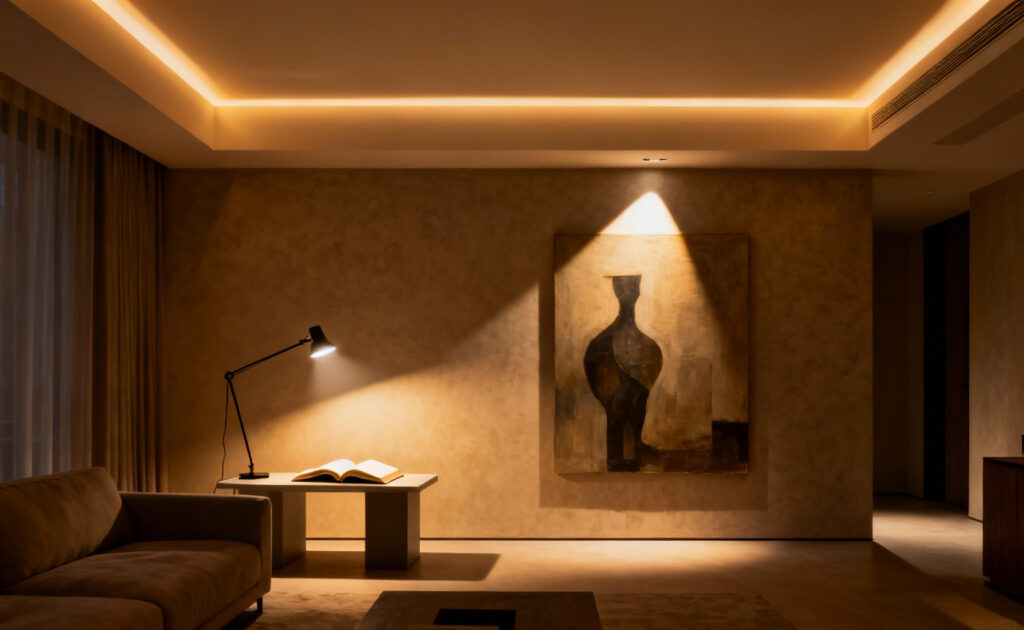I promise your home can become a living gallery, a space sculpted not just with objects, but with light itself. As a curator, I’ve spent my career observing how illumination can give a piece of art soul, and I’m here to tell you that the same principles apply to the rooms we live in. Mastering this isn’t about buying the most expensive fixtures; it’s about understanding light as an artistic medium. After years of designing exhibitions and helping collectors integrate art, I’ve distilled the process into 20 curatorial secrets for masterful living room lighting. These aren’t fleeting trends. They are the foundational choices that create spaces that feel intentional, deeply personal, and truly alive. Let’s move beyond simply lighting a room and begin to compose with light.
The Philosophical Anchor – Cultivating Luminous Narratives (Part 1)
Before we touch a single switch, we need to think like an artist. Light tells a story. It sets the mood, directs the eye, and gives form to everything in a room. This is about establishing a point of view for your space, a foundational philosophy that will guide every choice you make.
1. Orchestrate a Hierarchy of Light for Visual Depth
A room with one single, flat light source feels lifeless—like a photograph with no contrast. The secret, which we live by in the gallery world, is layering. Think of your lighting in three distinct, harmonious parts: Ambient, Task, and Accent. Ambient is your general, foundational glow, the soft light that makes the room feel welcoming. Task lighting is your focused workhorse—the lamp you read by, the light that illuminates a workspace. And then, the magic touch: Accent lighting. This is the gallery secret. It’s the precisely aimed light that makes a painting pop, that grazes a textured wall, or that makes a piece of sculpture feel like it’s breathing.
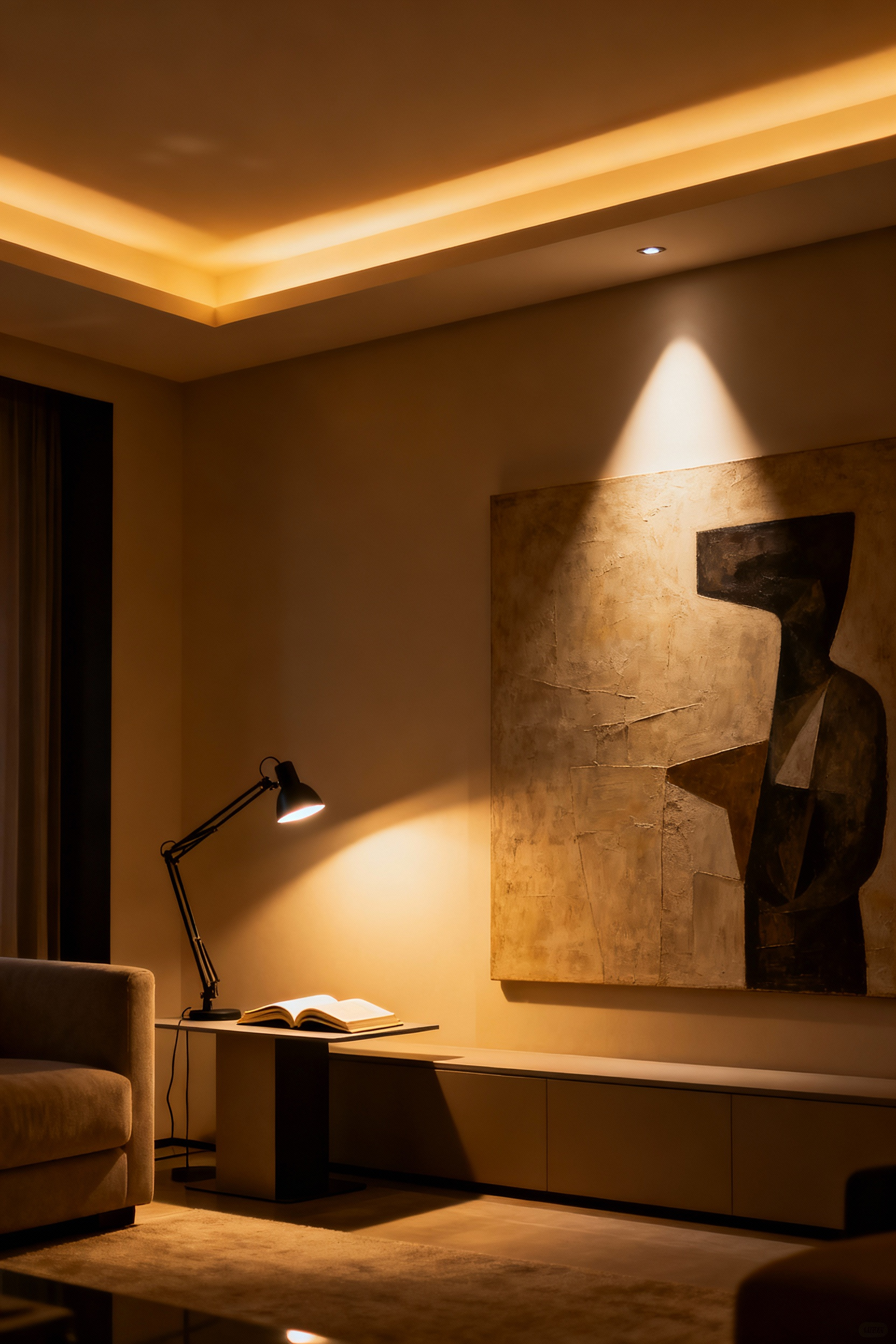
What I always tell emerging collectors is that an artwork isn’t truly “placed” until it’s lit. Without that focused beam, it’s just another object on the wall. This intentional layering is what creates visual rhythm and depth, guiding the eye and transforming a simple room into a curated experience. Dimmers on everything are non-negotiable; they are your baton for conducting this orchestra of light.
2. Leverage Color Temperature to Define the Ambient Mood
Have you ever noticed how the light at sunset makes everything feel warm and intimate, while the midday sun feels energizing and crisp? That’s color temperature at work, measured in Kelvin (K). This is one of the most powerful, yet overlooked, tools in your arsenal. For a living room, a space designed for comfort and connection, you almost always want to live in the warmer end of the spectrum—think 2200K to 3000K. This range mimics candlelight and incandescent warmth, fostering a sense of cozy sanctuary.
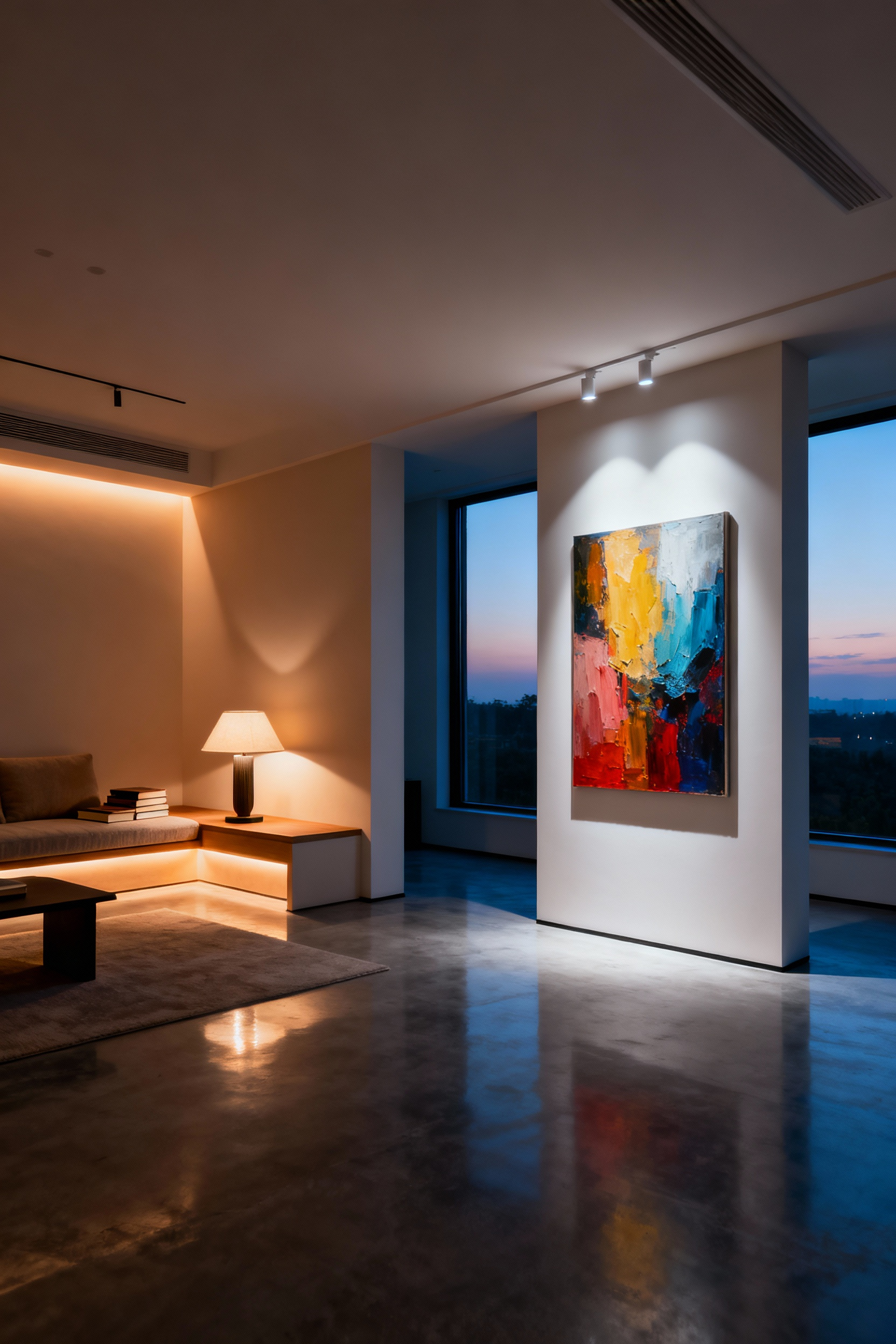
From my gallery curator background, I can tell you that an artwork’s colors can be completely distorted by the wrong color temperature. The same is true for your home. That beautiful gray-green on your walls can look sickly under a cool, sterile light. Your goal is a warm, inviting glow that renders the colors of your life—your art, your textiles, your family’s faces—in their best and truest light.
3. Employ Lumen Contrast to Accentuate Architecture and Art
Contrast is what creates drama and focus. Lumen contrast is simply the difference in brightness between one area and another, and it’s how you tell people what’s important. If everything is equally bright, nothing stands out. You must choose what you want to celebrate. A beautiful fireplace, a soaring ceiling, a cherished painting—these are your focal points. You honor them by giving them more lumens, a brighter stage.
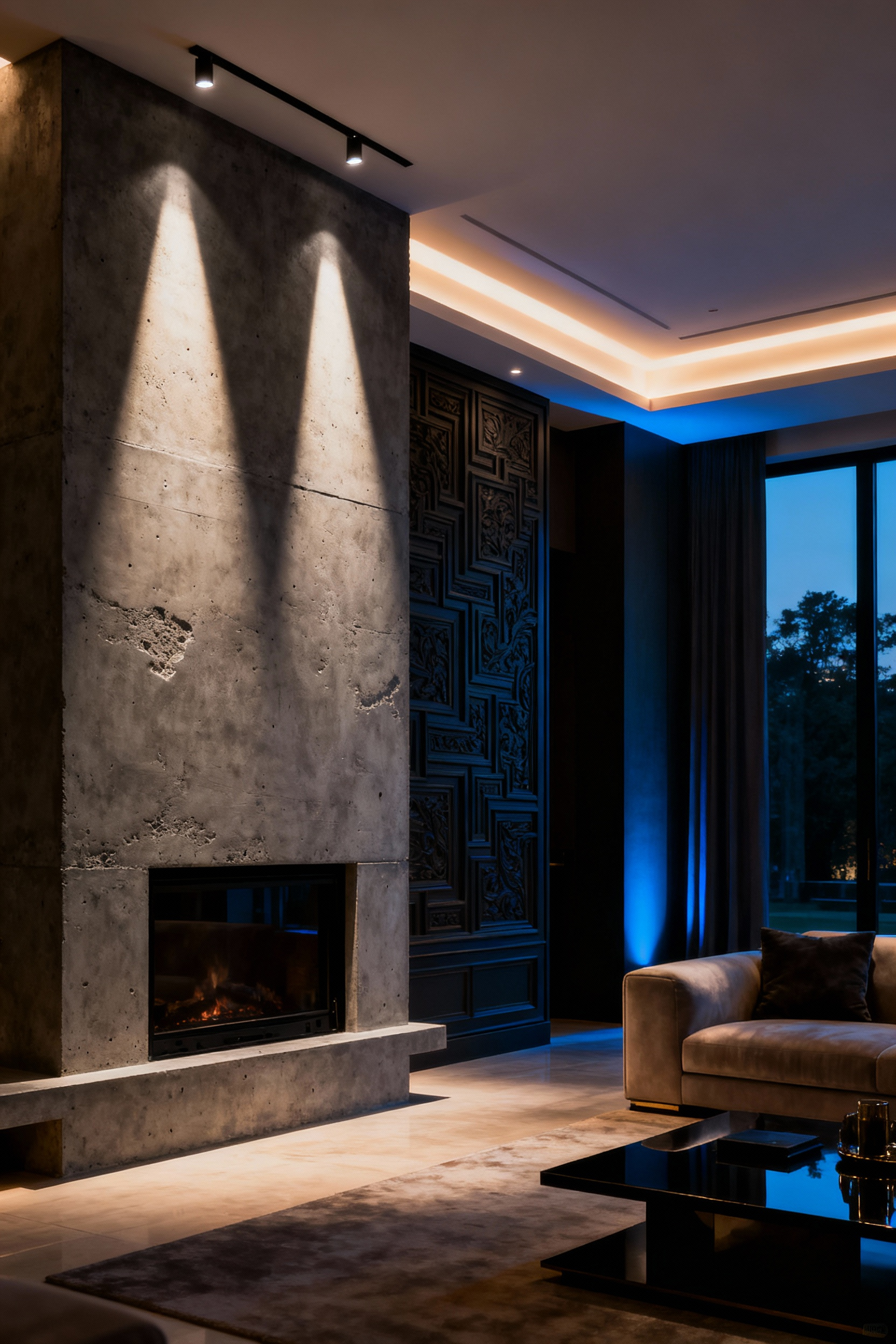
I’ve noticed that people are often afraid of shadows, but shadows are what give form and dimension. By directing a powerful, focused beam of light onto a piece of art while leaving the surrounding wall in softer light, you create a magnetic pull. Your eye goes right there. You are, in essence, curating the visual journey through your room, telling a story of what matters most to you.
4. Mitigate Glare by Dispersing Light Judiciously
Nothing destroys a sophisticated atmosphere faster than glare. That sharp, intrusive light that makes you squint is the enemy of comfort and elegance. The most masterfully lit spaces are ones where you feel the beautiful effect of the light without necessarily seeing the source. This is the art of judicious dispersal.
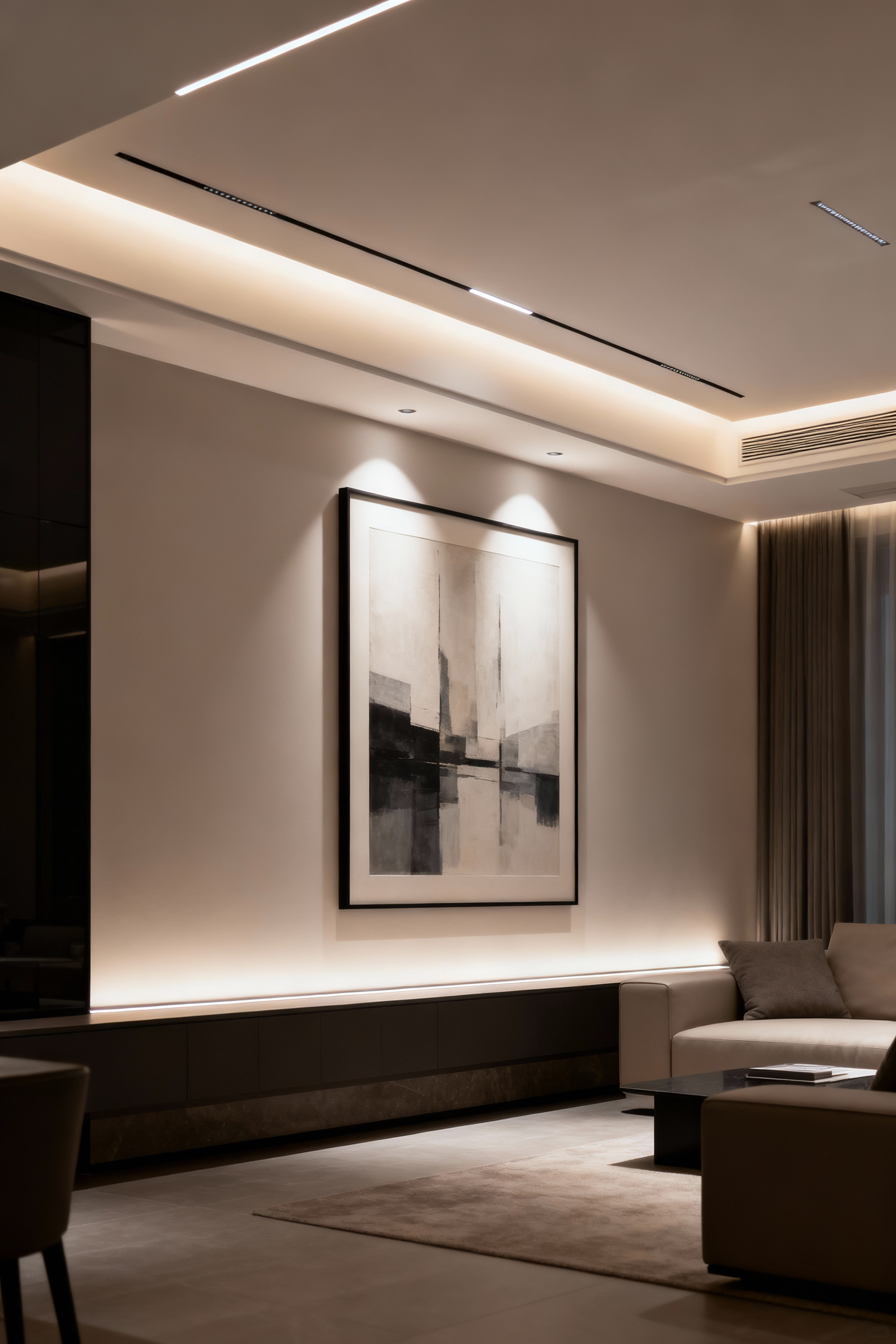
Here’s what’s interesting: it’s not about having less light, but about making it gentler. Opt for recessed lights with deep baffles that conceal the bulb, or choose pendants and sconces with frosted or linen shades that diffuse the glow. I learned this when lighting a collection of delicate watercolors; direct light would have created reflective hotspots, so we bounced light off the ceiling instead. This indirect approach creates a soft, even wash that feels utterly serene and makes the entire room the source of illumination.
The Philosophical Anchor – Cultivating Luminous Narratives (Part 2)
Now that we understand how to add light, we must appreciate its partner: shadow. A masterfully lit space is as much about what is concealed as what is revealed. This is where the true artistry begins—in the deliberate shaping of darkness to create mood, mystery, and intimacy.
5. Master Shadow Play by Infusing Drama with Absence
The most compelling art often uses negative space to define the subject. In lighting, shadow is your negative space. An evenly flooded room lacks mystery and intimacy. By allowing pools of darkness to exist, you create a more dynamic, engaging environment. You sculpt the space, carving out cozy nooks and dramatic focal points. An uplight at the base of a plant, for example, will cast dramatic, large-scale shadows on the ceiling, turning a simple ficus into a piece of kinetic sculpture.
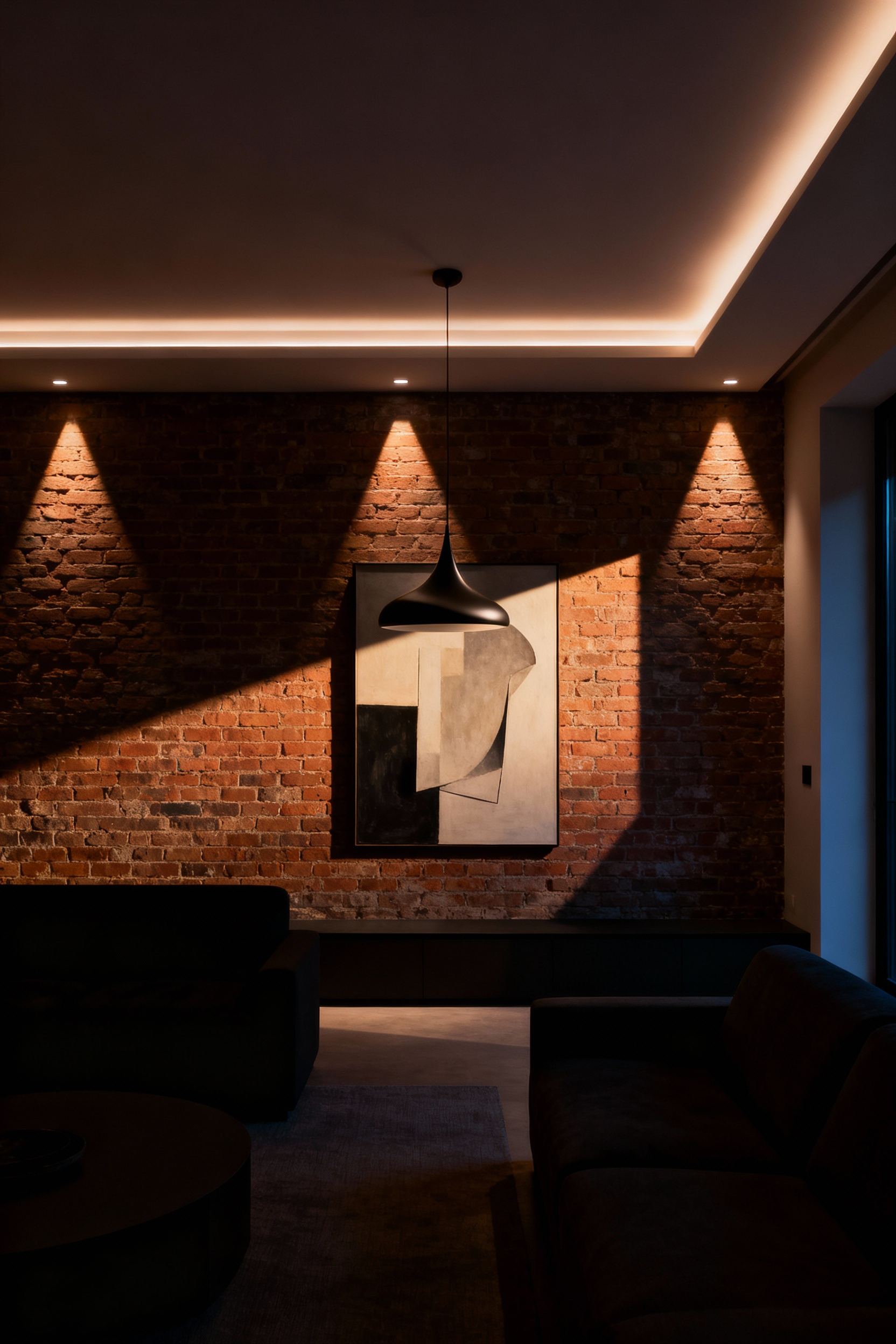
What I tell my art enthusiasts and design-conscious homeowners is to stop trying to eliminate every shadow. Instead, learn to control them. A single, focused spotlight on an armchair in a dim corner doesn’t just light the chair; it creates an intimate, personal sanctuary defined by the surrounding softness. You’re using the absence of light to signal quiet and refuge. It’s a bold, confident move that elevates your living room lighting from merely functional to deeply expressive.
Material Exploration – Curating Luminaire Elements (Part 1)
The light fixture itself is a piece of sculpture in your home. The materials, the form, and the way it shapes light are critical curatorial choices. We’re moving from the abstract philosophy to the tangible objects that will bring your vision to life.
6. Differentiate Between Directional vs. Diffused Luminaires
Think of your light fixtures as a set of artist’s brushes. You have broad brushes for wide washes of color and fine-tipped brushes for precise detail. A diffused luminaire—like a paper lantern or a fabric drum shade—is your broad brush. It scatters light in all directions, creating a soft, ambient glow that reduces harsh shadows and makes a space feel open and inviting. It’s the foundation of your lightscape.
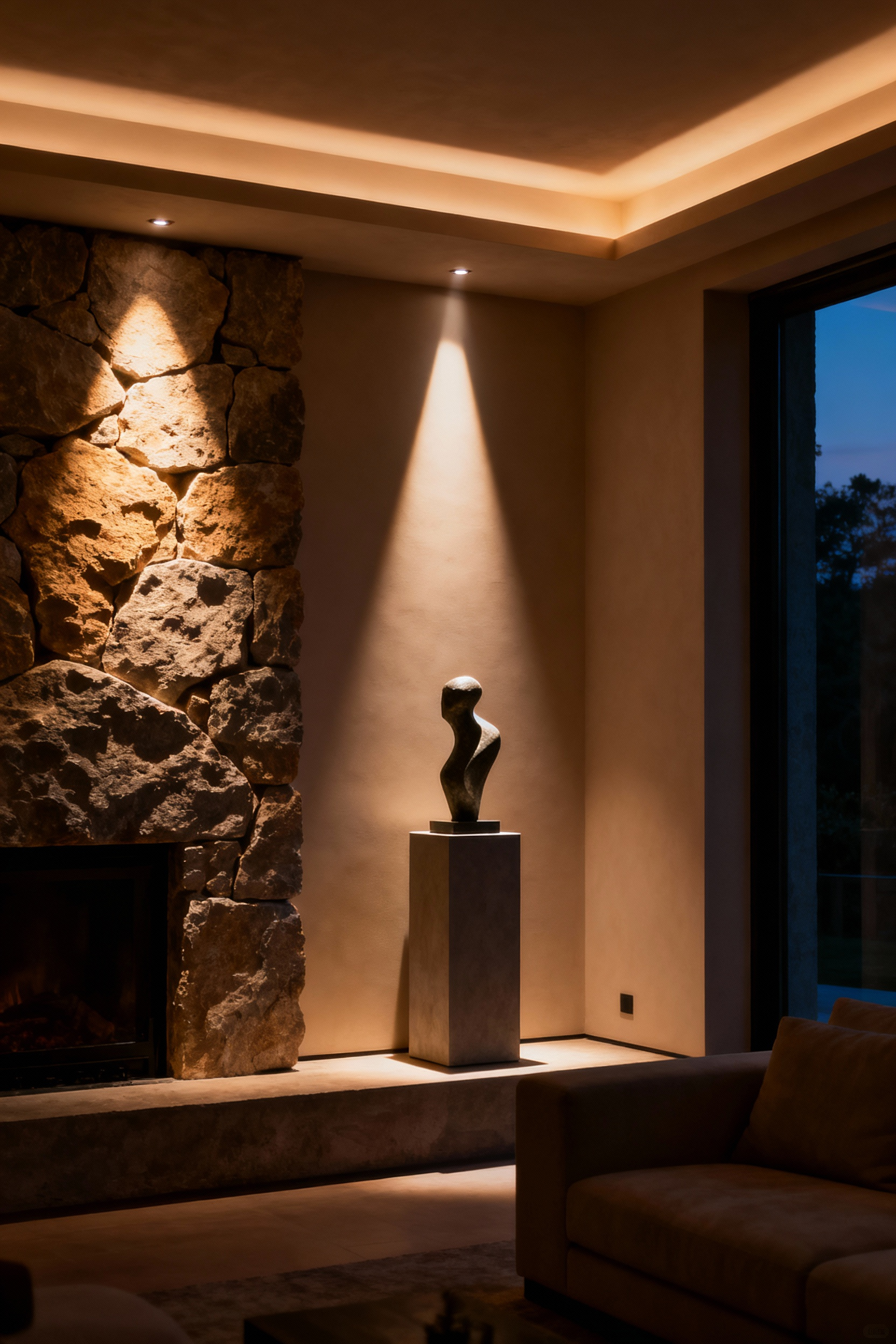
A directional luminaire—a spotlight, a track light, a reading lamp—is your detail brush. It creates a controlled cone of light designed for a specific purpose, whether it’s highlighting a sculpture or illuminating the pages of your book. In my experience with contemporary art curation and integration, a common mistake is using only diffused light. The result is a pleasant but boring room. You need both: the soft harmony of diffusion and the intentional drama of direction.
7. Integrate Architectural Recessed Fixtures for a Seamless Look
There are times when the lighting should be felt but not seen. Architectural recessed fixtures are the ultimate expression of this minimalist ideal. They disappear into the ceiling, allowing the architecture and the objects within the room to take center stage. They provide clean, powerful illumination without adding any visual clutter. It’s a very contemporary, gallery-like approach.
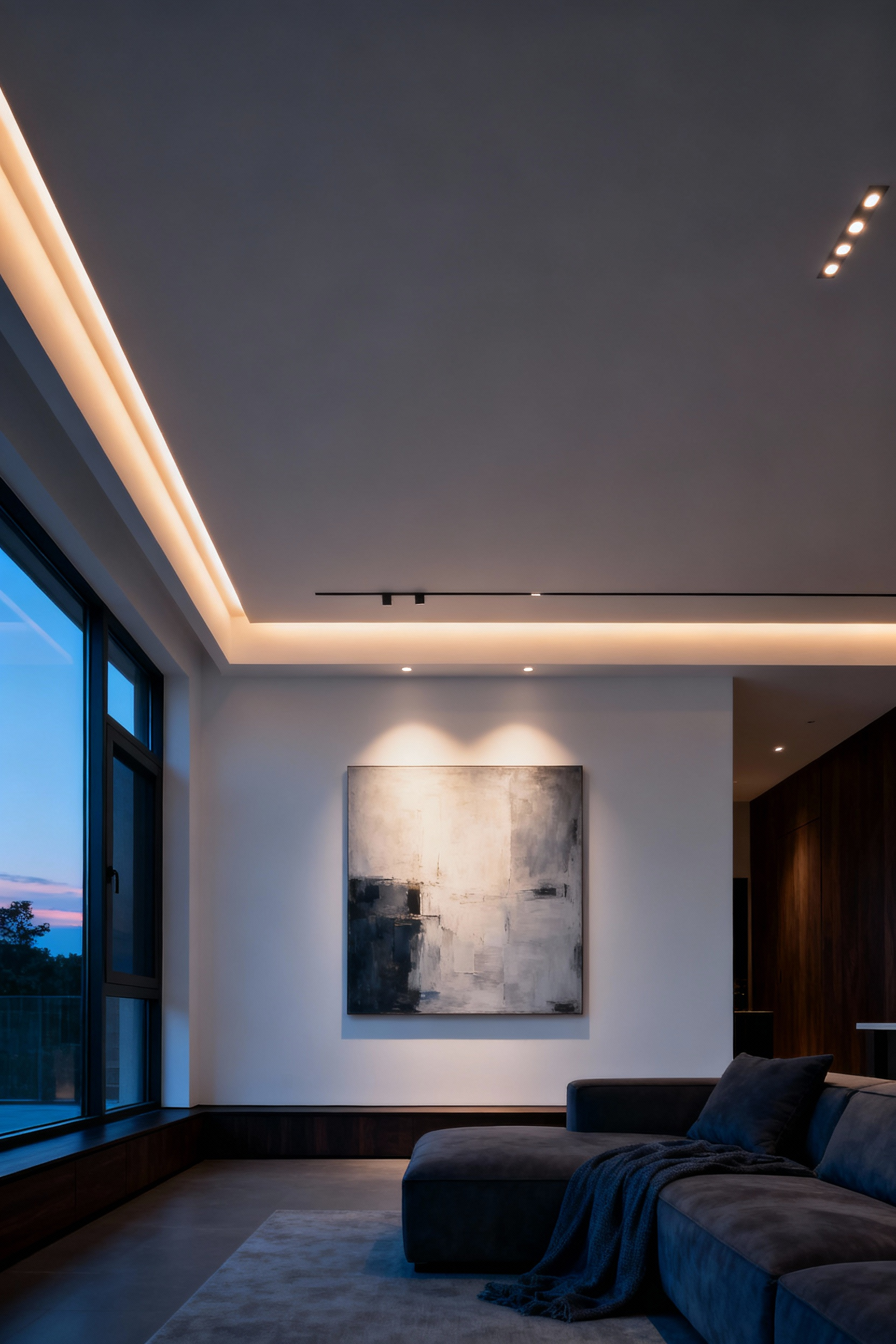
But don’t think of them as just simple downlights. They are incredibly versatile tools. You can use them for an even “wall wash,” which bathes an entire surface in a smooth gradient of light, making a room feel larger and highlighting a collection of art. Or you can opt for adjustable “eyeball” fixtures to pinpoint specific objects with precision. The key is quality; look for fixtures with deep baffles and good optics to control the beam and eliminate that distracting glare at the source.
8. Harness Artful Pendants as Sculptural Focal Points
While recessed lighting aims for invisibility, a statement pendant demands to be seen. Think of it as a piece of functional sculpture suspended in space. It’s an opportunity to introduce a specific material—hand-blown glass, brushed brass, woven rattan—that adds texture and personality. An artful pendant doesn’t just provide light; it anchors a space. Hung low over a coffee table, it creates a visual centerpiece for a seating area, defining it as a hub for conversation.
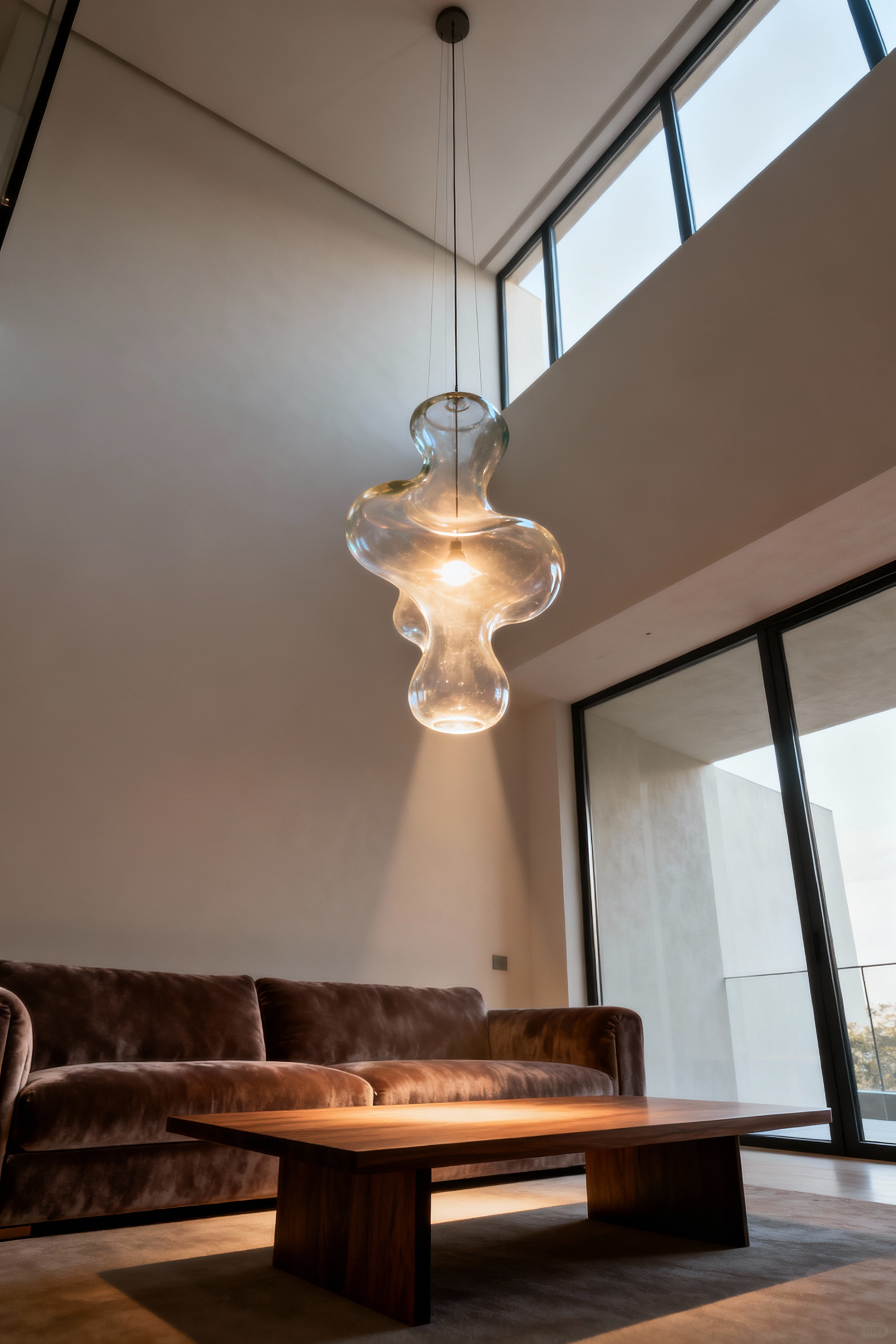
What really gets me is when a beautiful pendant is hung too high, looking lost and disconnected. Placement is everything. It needs to relate to the furniture beneath it, creating a cohesive vignette. It’s a powerful tool for adding vertical interest to a room and expressing your personal aesthetic in a bold, deliberate way. This is your chance to bring in the work of an artist or artisan and make it a central part of your living room’s story.
9. Exploit Table and Floor Lamps as Functional Art Objects
Table and floor lamps are the most personal and versatile pieces in your lighting collection. They are the finishing touches, the jewelry of the room. I encourage clients to think of them as small sculptures that happen to emit light. A vintage Murano glass lamp on a side table or a sleek, architectural floor lamp standing by a chair adds immense character and provides that crucial, human-scale layer of light.
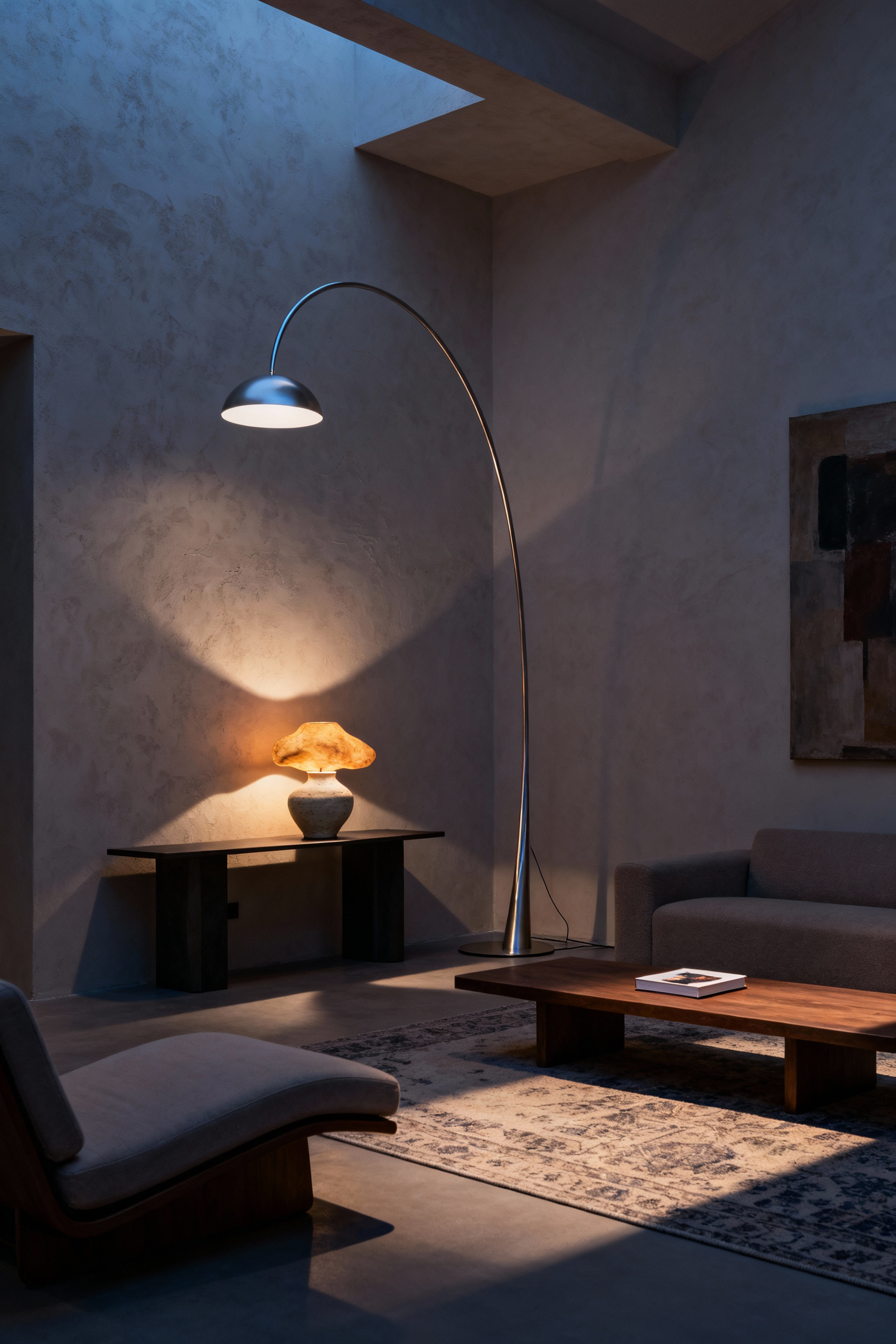
These lamps are your chance to build intimate moments within the larger room. A pool of warm light on a side table, illuminating a stack of books and a small object, creates a beautiful, quiet vignette. I’ve noticed that the most successful spaces use a variety of lamp styles, heights, and materials. This mix feels collected and curated over time, rather than purchased as a set, and allows for incredible flexibility in crafting the perfect mood.
Material Exploration – Curating Luminaire Elements (Part 2)
Let’s dive deeper into a more architectural approach to lighting, exploring how integrated, almost invisible sources can create some of the most dramatic and sophisticated effects. Here, the material is not the fixture, but light itself becoming part of the room’s structure.
10. Employ Linear LED Strips for Subtle Grazing and Coving
This is where lighting truly merges with architecture. Linear LED strips are a game-changer because they allow you to place light in ways that were previously impossible. Tucked into a ceiling cove, they cast a sublime, indirect glow that seems to emanate from the architecture itself, making the ceiling feel higher and the room more spacious. Hidden beneath a floating shelf or cabinet, they create a weightless effect while highlighting the objects on display.
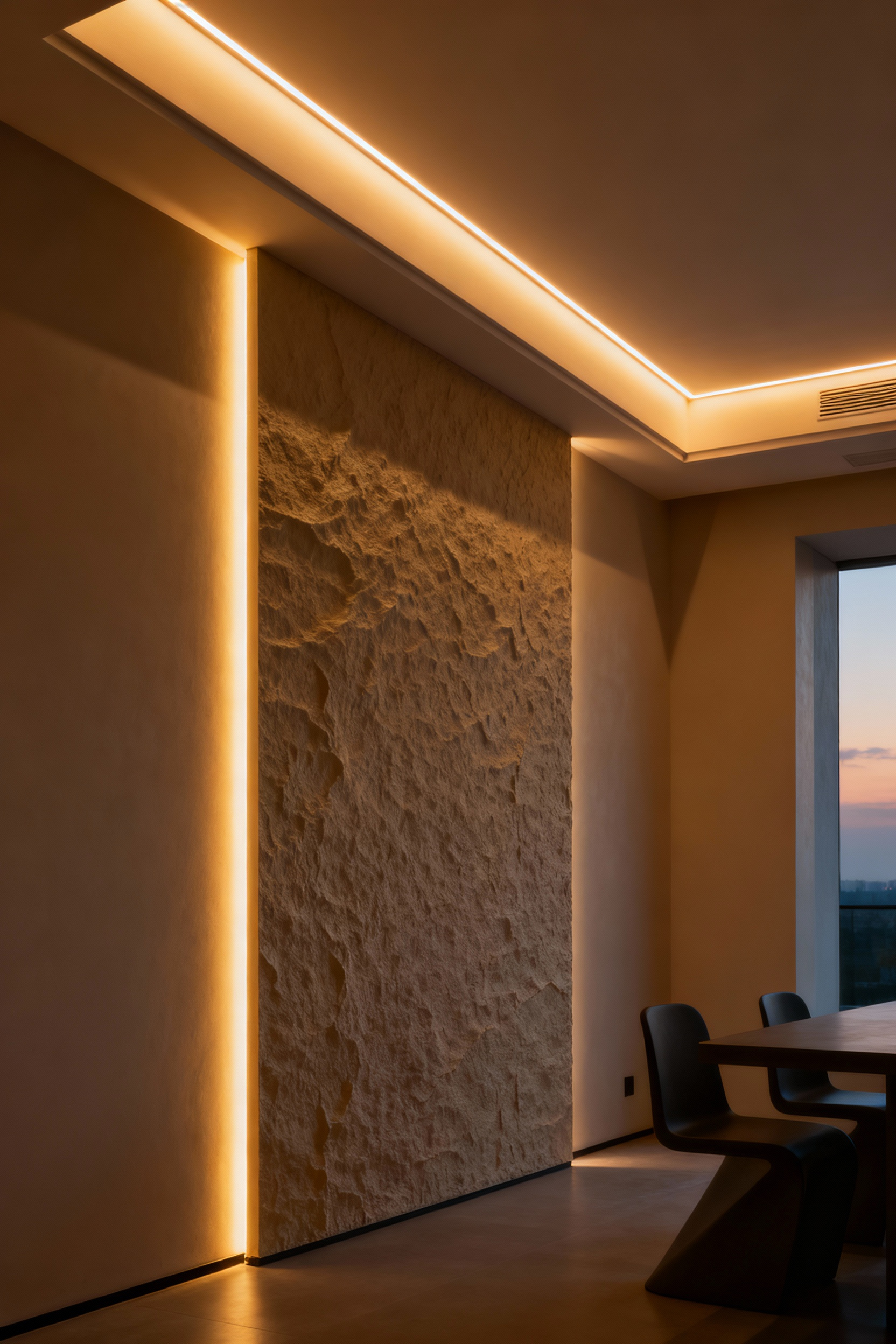
My favorite application, however, is wall grazing. By placing a linear strip close to a textured surface—like exposed brick, Venetian plaster, or a stone feature wall—you cast light at a sharp angle. This creates dramatic shadows that reveal the incredible depth and tactility of the material. It transforms a flat wall into a dynamic, three-dimensional work of art. It’s a technique we use in galleries to bring out the subtle textures in large-scale canvases or sculptures.
Spatial Application – Sculpting Illumination Zones (Part 1)
Now that we have our palette of fixtures, it’s time to apply them. This is about sculpting specific zones within the living room, using light to define function and create purpose-built atmospheres for conversation, reading, and appreciating art.
11. Design Conversational Niches with Intimate Pools of Light
Great living rooms are designed for human connection. You can encourage this by using light to create intimate “conversational niches.” Instead of blasting a whole seating area with overhead light, craft a more focused pool of illumination. A low-hanging pendant over a coffee table, combined with warm table lamps on either side of a sofa, draws a soft, luminous boundary. It subconsciously encourages people to lean in, to connect.
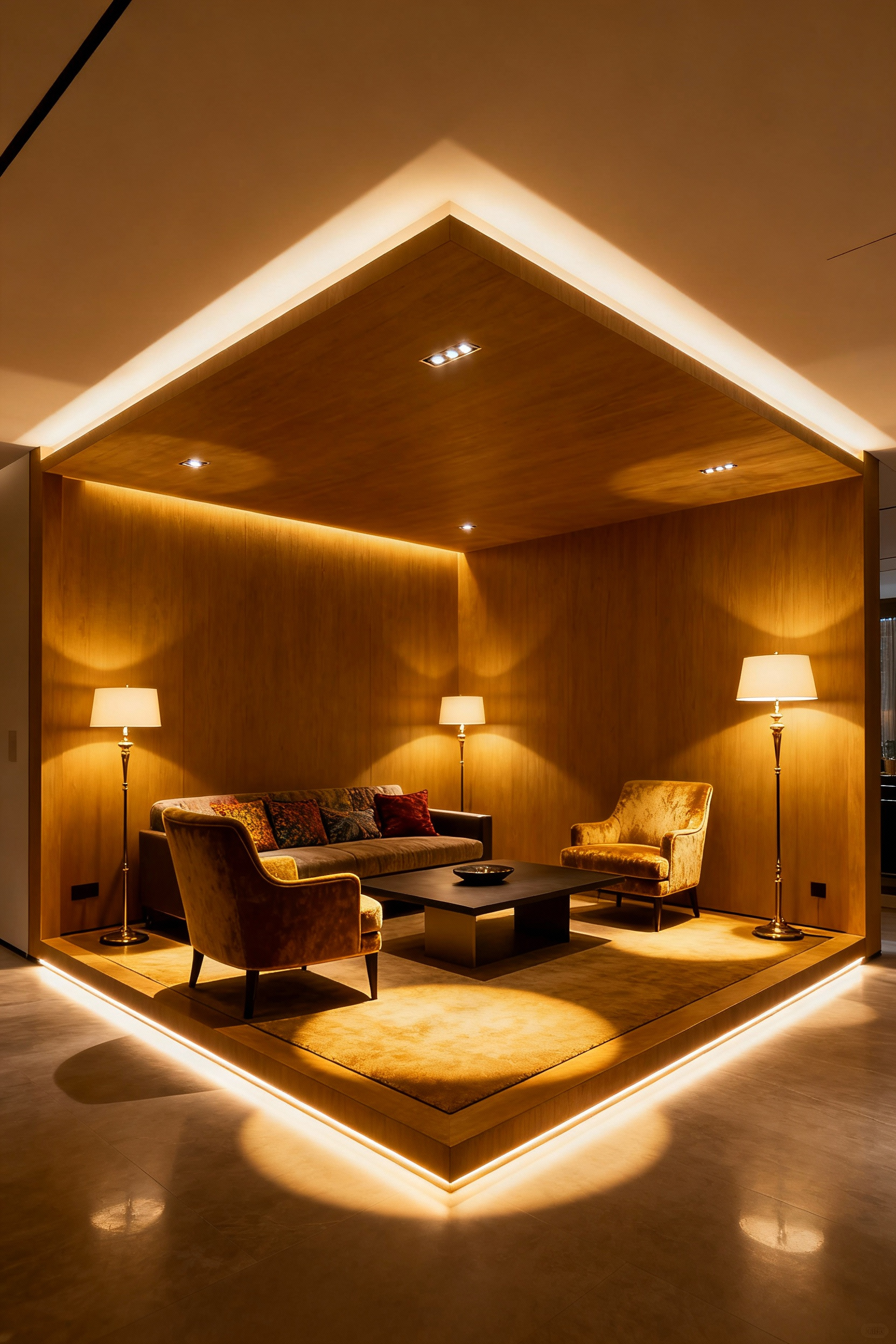
The goal is to light the people and the immediate space, not the entire room. I’ve seen this play out in gallery openings time and again; people naturally gravitate toward the pockets of softer, warmer light to talk. By dimming the surrounding ambient light and focusing on these intimate pools, you create a space that feels like a welcoming embrace.
12. Accentuate Curated Artworks with Precision Spot Illumination
Your art and treasured objects deserve to be seen properly. This requires precision. The goal is to illuminate the piece itself, not the wall around it. We use a “30-degree rule” in galleries: the light source should hit the artwork at about a 30-degree angle to minimize glare and distracting shadows from the frame. For a painting, a single, focused spotlight or a classic picture light works beautifully. For a three-dimensional sculpture, you might use two or three lights from different angles to model its form and reveal its texture.

Here’s what’s important: the light source must have a high Color Rendering Index (CRI), ideally 90 or above. This ensures you’re seeing the true, vibrant colors the artist intended. A low CRI light can make a brilliant red look muddy and a deep blue appear flat. Investing in high-CRI accent lighting is the single most important thing you can do to honor the art you’ve chosen to live with.
13. Integrate Task-Specific Lighting for Reading Sanctuaries
A living room should also be a place for personal retreat. A well-designed reading sanctuary is a gift you give yourself. This requires a dedicated task light—a beautiful floor lamp with an adjustable arm or a swing-arm sconce mounted on the wall—that can be positioned to cast clear, focused light directly onto your book or magazine without causing glare. The light should be bright enough for comfortable reading but contained enough that it doesn’t disrupt the overall ambient mood of the room.
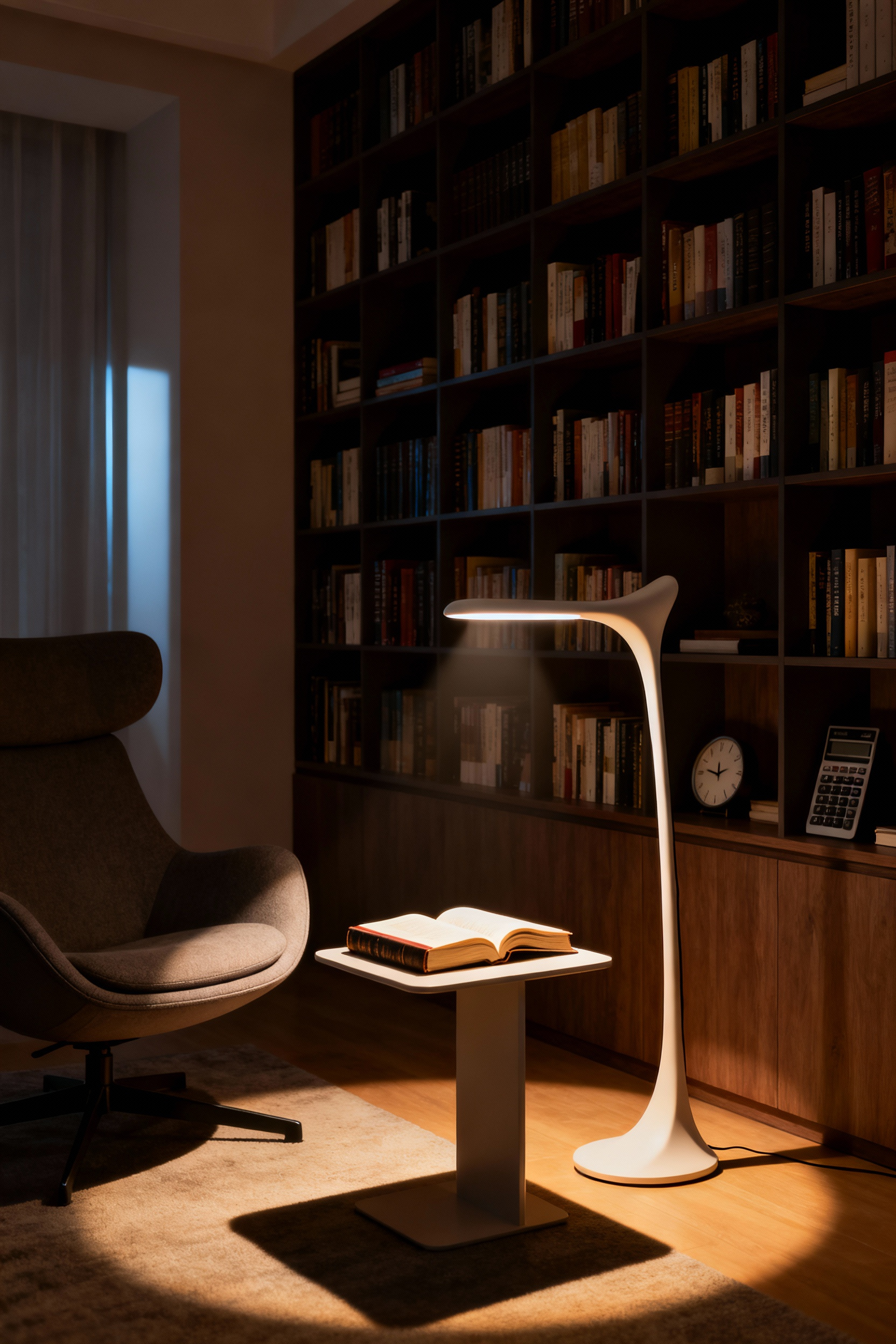
What I tell my clients is that this light should be on its own switch or control. The act of turning on your reading lamp becomes a small ritual, a signal to yourself and others that you’re entering a quiet, focused state. It’s a simple but powerful way to embed moments of personal well-being into the design of your home.
14. Activate Wall Washers to Amplify Textural Surfaces
Beyond highlighting individual objects, you can treat an entire wall as a canvas. A “wall wash” is a technique where you use a series of lights—often recessed fixtures or a track—to cast a smooth, even layer of illumination across a vertical surface. This simple act has a profound effect: it makes the room feel significantly larger, brighter, and more polished.
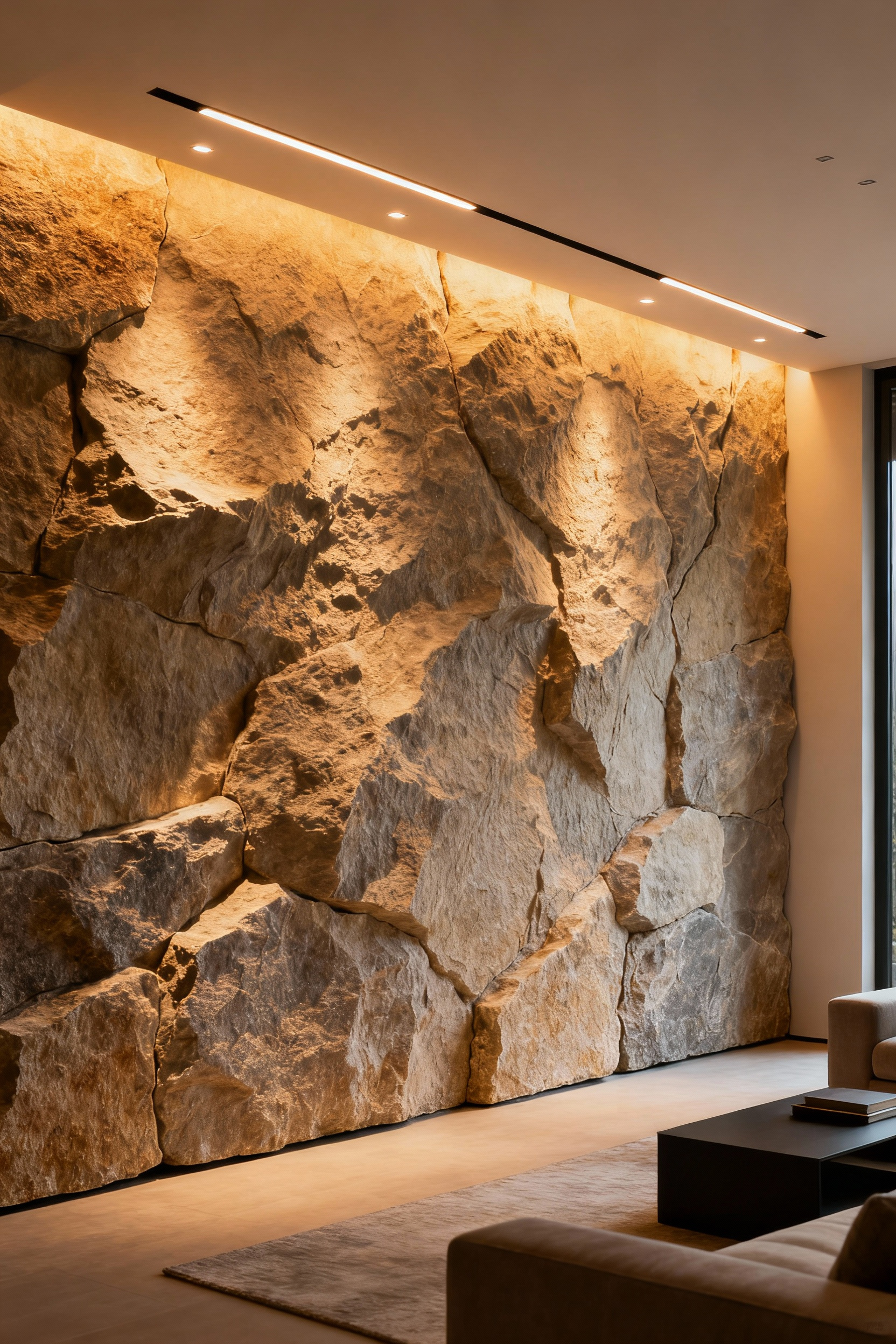
From my work in exhibition design, I know that a perfectly executed wall wash can give a room an incredible sense of serenity and grandeur. It’s particularly effective on walls with subtle texture, such as grasscloth or linen wallpaper, as it softly enhances their material quality. It creates a beautiful, luminous backdrop that makes all the other layers of light and objects in front of it feel more intentional and cohesive.
Spatial Application – Sculpting Illumination Zones (Part 2)
The most dynamic source of light is free and changes constantly: the sun. A truly holistic lighting plan doesn’t just add artificial light; it expertly manages natural light, treating your windows as the most powerful luminaires you own.
15. Modulate Natural Light with Thoughtful Window Treatments
Think of your window treatments as filters and shapers of natural light. They are not just for privacy. A layer of sheer curtains diffuses harsh afternoon sun into a soft, ethereal glow, filling the room with beautiful ambient light while cutting glare. Behind them, a heavier drape or a blackout shade gives you the ability to create complete darkness for a movie or simply to control the mood.
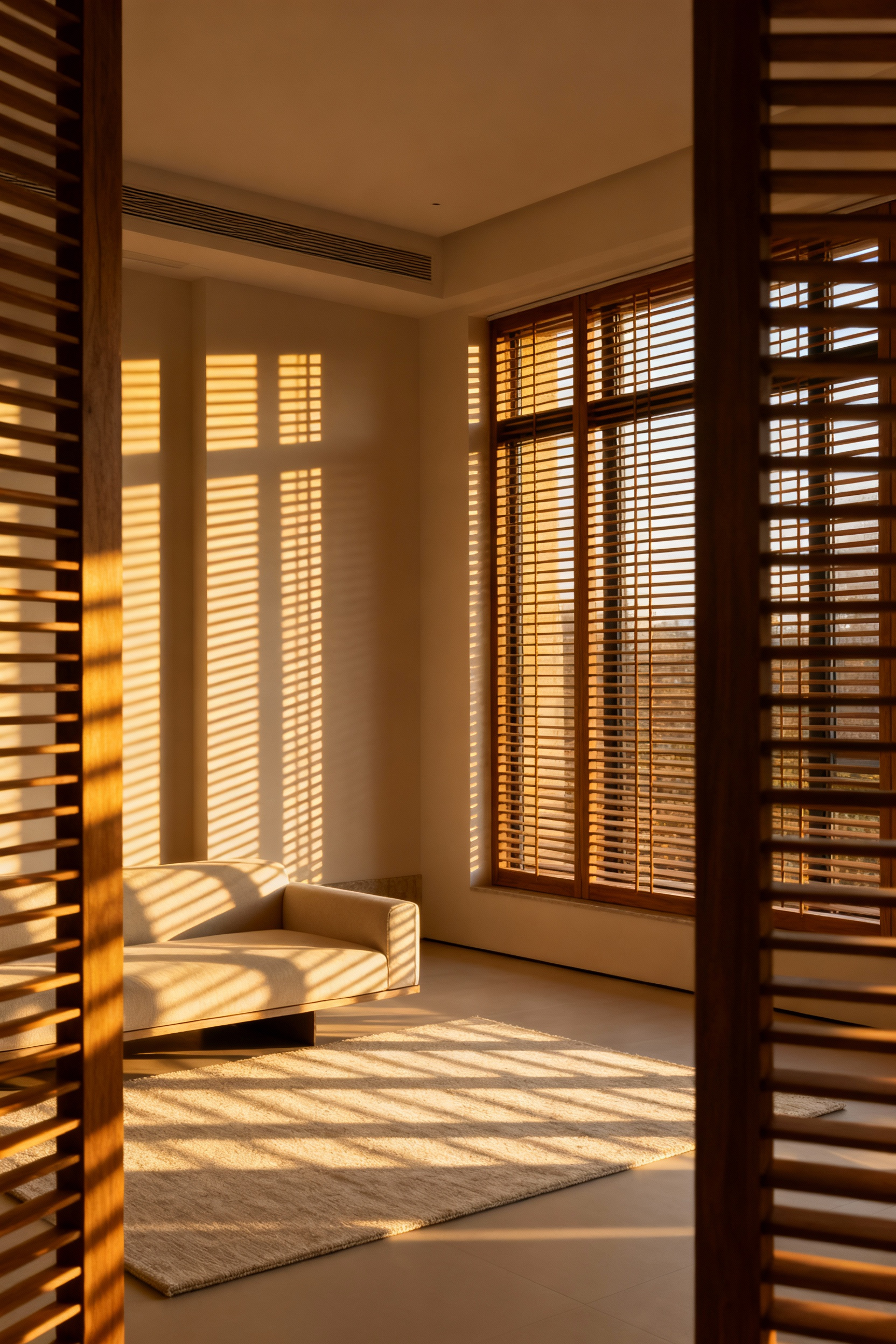
What’s really interesting is how these choices interact with your interior. Light filtering through a linen sheer adds a soft texture to the room. Light reflecting off a silk drape has a unique shimmer. These aren’t just functional decisions; they are aesthetic ones. Mastering the interplay between natural and artificial light is what separates good design from great design, allowing your room to feel alive and responsive from sunrise to sunset.
Lifestyle Integration – Harmonizing Light with Living Rhythms (Part 1)
Truly advanced living room lighting is intuitive and responsive. It adapts to your needs, your moods, and even your biology. This is where technology meets well-being, creating an environment that actively supports the way you live.
16. Implement Tunable White Systems for Circadian Well-being
This is one of the most exciting frontiers in lighting. Our bodies are naturally attuned to the sun’s changing color temperature throughout the day—cool and bright in the morning, warm and dim in the evening. Tunable white technology allows your indoor lighting to mimic this natural rhythm. You can program your lights to be crisp and blue-toned in the morning to help you feel alert and energized, and then gradually shift to a warm, amber glow in the evening to help you relax and prepare for sleep.
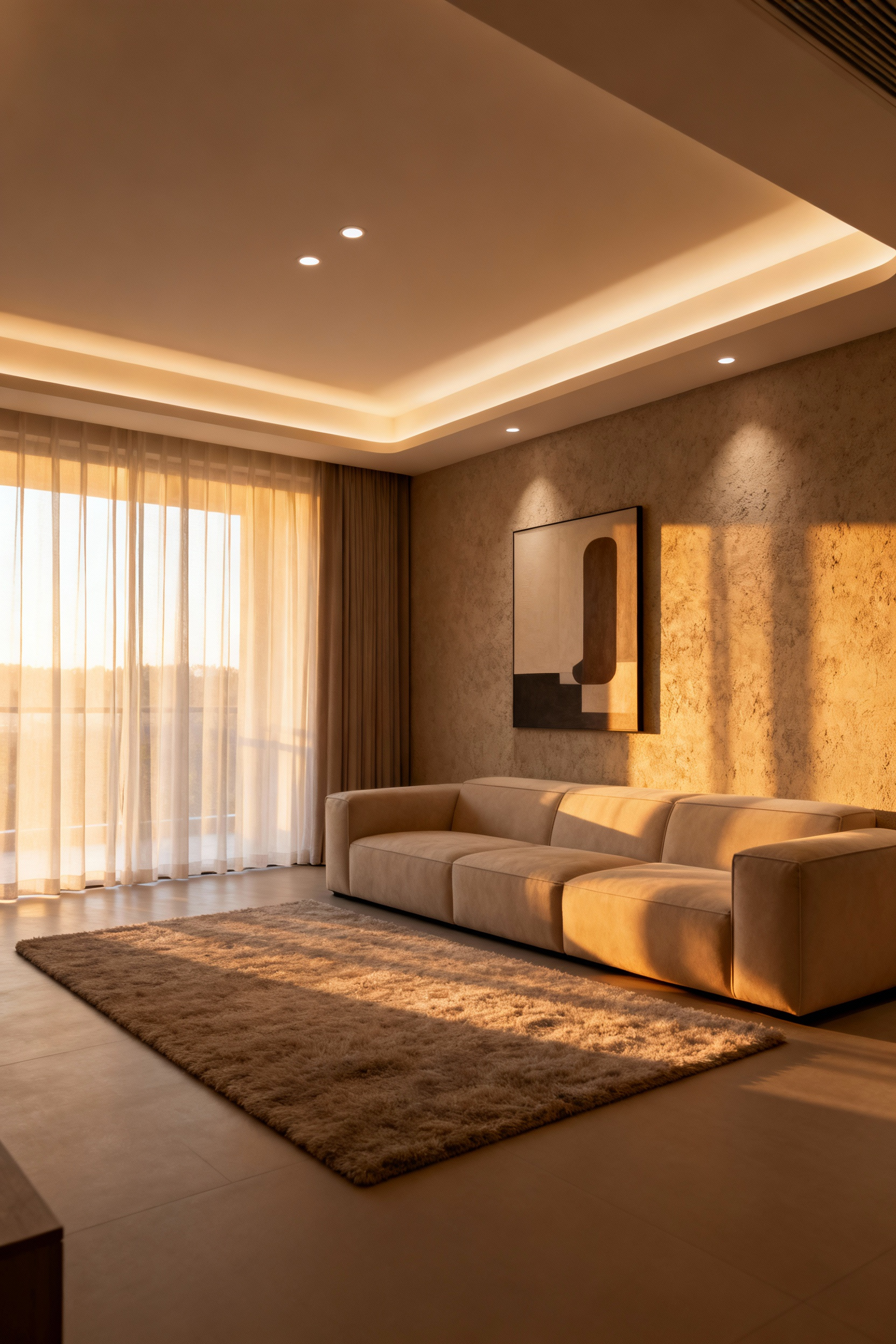
From a curatorial perspective, this is like having an infinite palette. You can ensure your art and interiors look their best at any time of day, but the wellness benefits are the real story. By aligning your indoor light with your natural circadian rhythm, you’re creating an environment that doesn’t just look good, but actively contributes to your health and well-being. It’s a profoundly human-centric approach to design.
17. Adopt Dimmable Systems for Granular Control
If I could only give one piece of lighting advice, it would be this: put everything on a dimmer. There is no such thing as a single “correct” brightness for a room. The ideal light level for a lively cocktail party is vastly different from what you want for a quiet evening with a book. Dimmers give you granular control, allowing you to fine-tune the intensity of each layer of light independently.
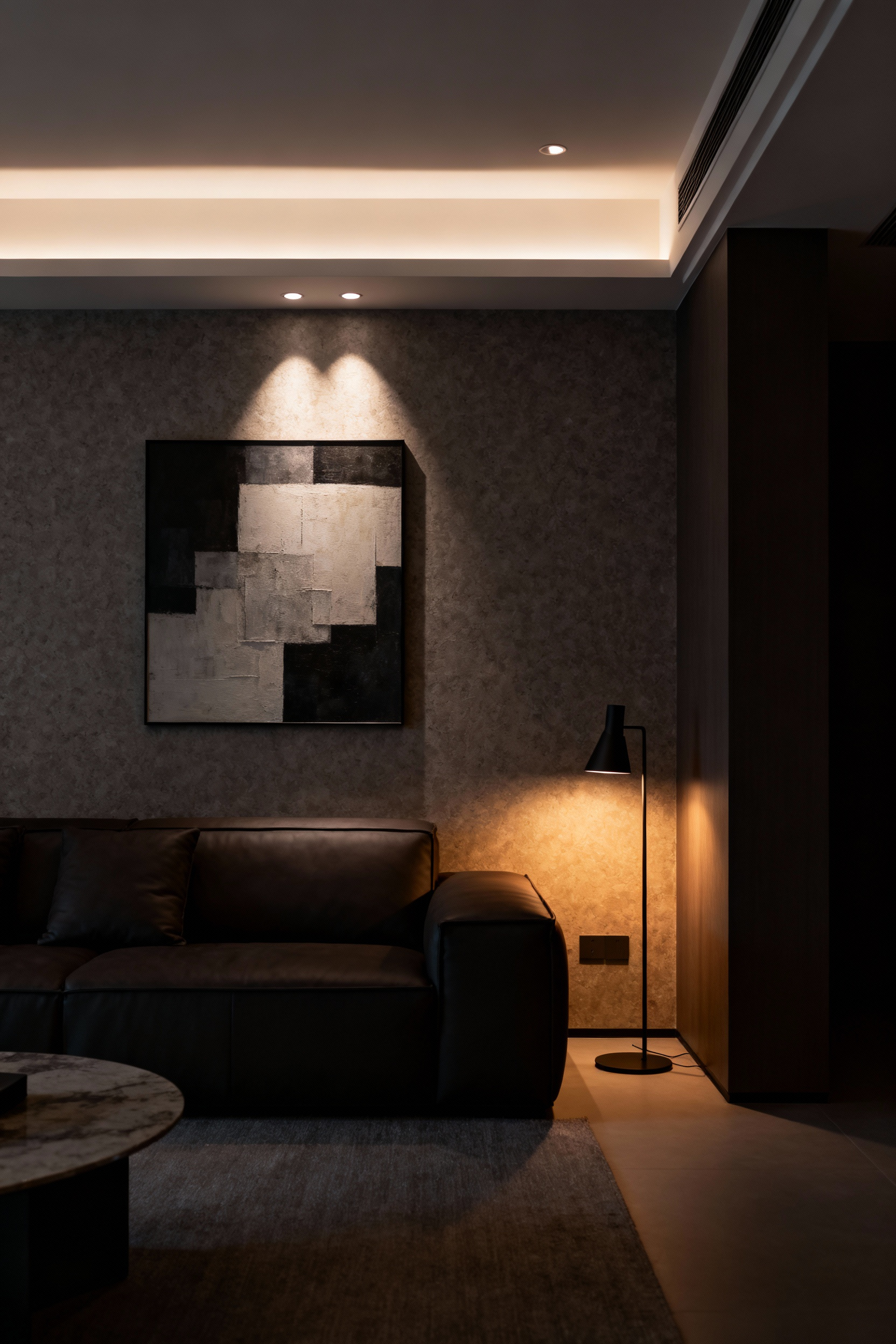
I’ve noticed that this ability to adjust is what empowers people to truly interact with their space. It moves them from being passive inhabitants to active curators of their own atmosphere. A quality dimming system that offers a smooth transition from full brightness down to a one-percent glow is a non-negotiable investment for a sophisticated and adaptable living room.
18. Program Dynamic “Scenes” for Different Activities
Once you have all your lights on dimmers, the next level of mastery is programming “scenes.” A smart lighting system allows you to create and save preset lighting combinations for different activities. With a single button press on a keypad or in an app, you can instantly call up your “Entertain” scene (bright, welcoming), your “Movie Night” scene (dim, with a soft backlight), or your “Reading” scene (focused task light on, ambient light down).
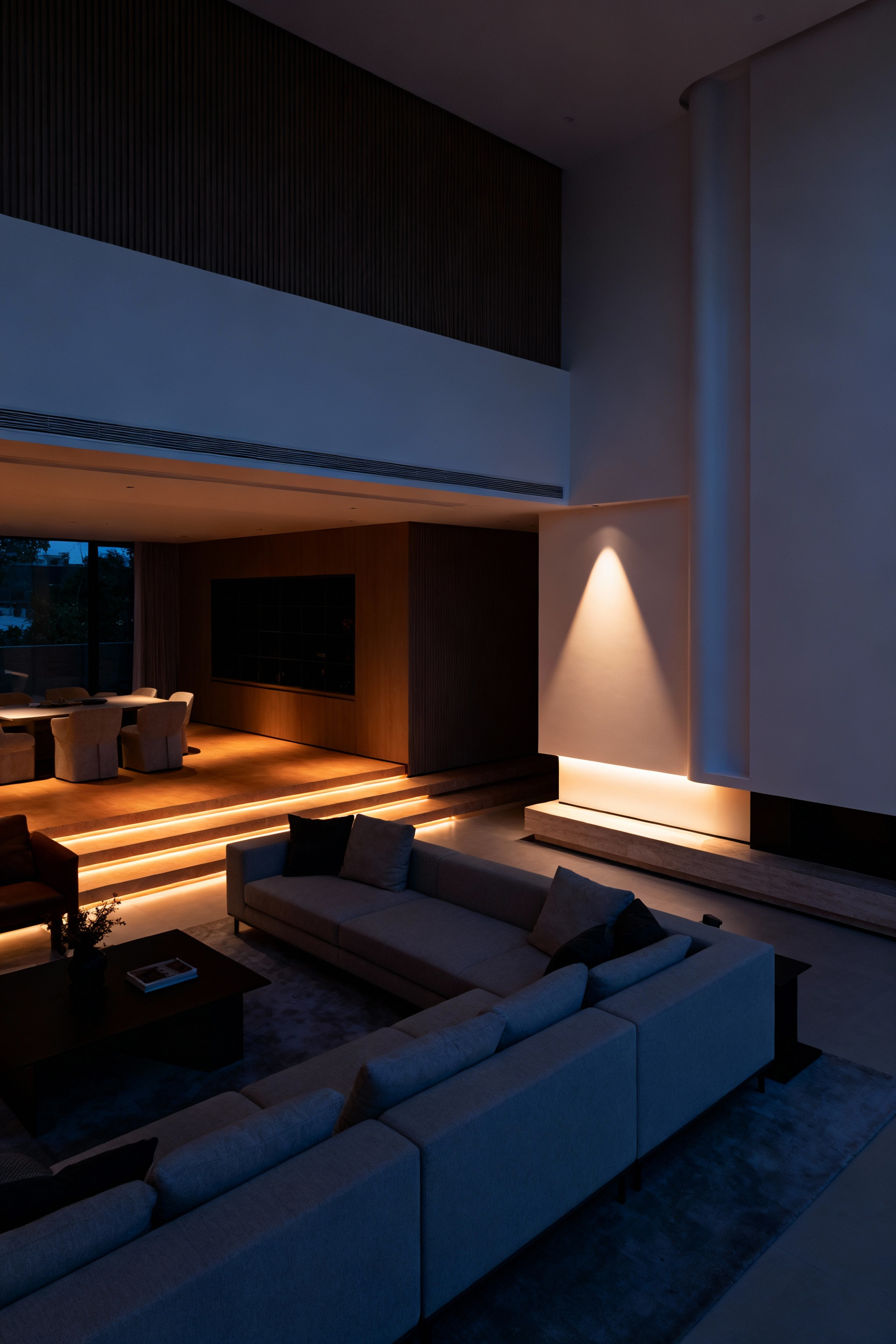
This isn’t just about convenience; it’s about living more intentionally. I learned this when designing gallery spaces where we need to switch from bright daytime viewing to moody evening event lighting instantly. By pre-programming these transitions, you remove the friction and guesswork, ensuring the atmosphere is always perfectly suited to the moment. It makes your home feel incredibly responsive and intelligent.
19. Integrate Voice and App-Based Management Platforms
The final layer of lifestyle integration is making control effortless. Voice assistants and smartphone apps remove the last physical barrier, allowing you to adjust your lighting with a simple command or a tap on a screen. Walking into a dark house with your hands full? “Alexa, turn on the welcome lights.” Settling into a movie and realizing the lights are too bright? You don’t have to get up.

This seamless control is the ultimate luxury. It allows your lighting system to recede into the background, becoming an intuitive extension of your will. For art enthusiasts, this means you can adjust the accent light on a new piece from across the room to see how it feels. It’s about making sophisticated control feel utterly natural, allowing you to stay focused on living, not on managing your home.
Lifestyle Integration – Harmonizing Light with Living Rhythms (Part 2)
A truly curated home is also a responsible one. The final consideration in our lighting plan is a commitment to sustainability and longevity. Smart choices here are not just good for the planet; they are the foundation of a resilient and thoughtfully designed home.
20. Consider Energy Efficiency and Longevity in Your Investments
The shift to LED technology has been a revolution. Modern LEDs use a fraction of the energy of their predecessors and can last for decades. When you are investing in fixtures for your home, especially architectural lighting that is built-in, prioritizing high-quality, long-lasting LEDs is the most intelligent decision you can make. It’s a “fit and forget” approach that saves money on energy bills and significantly reduces maintenance.
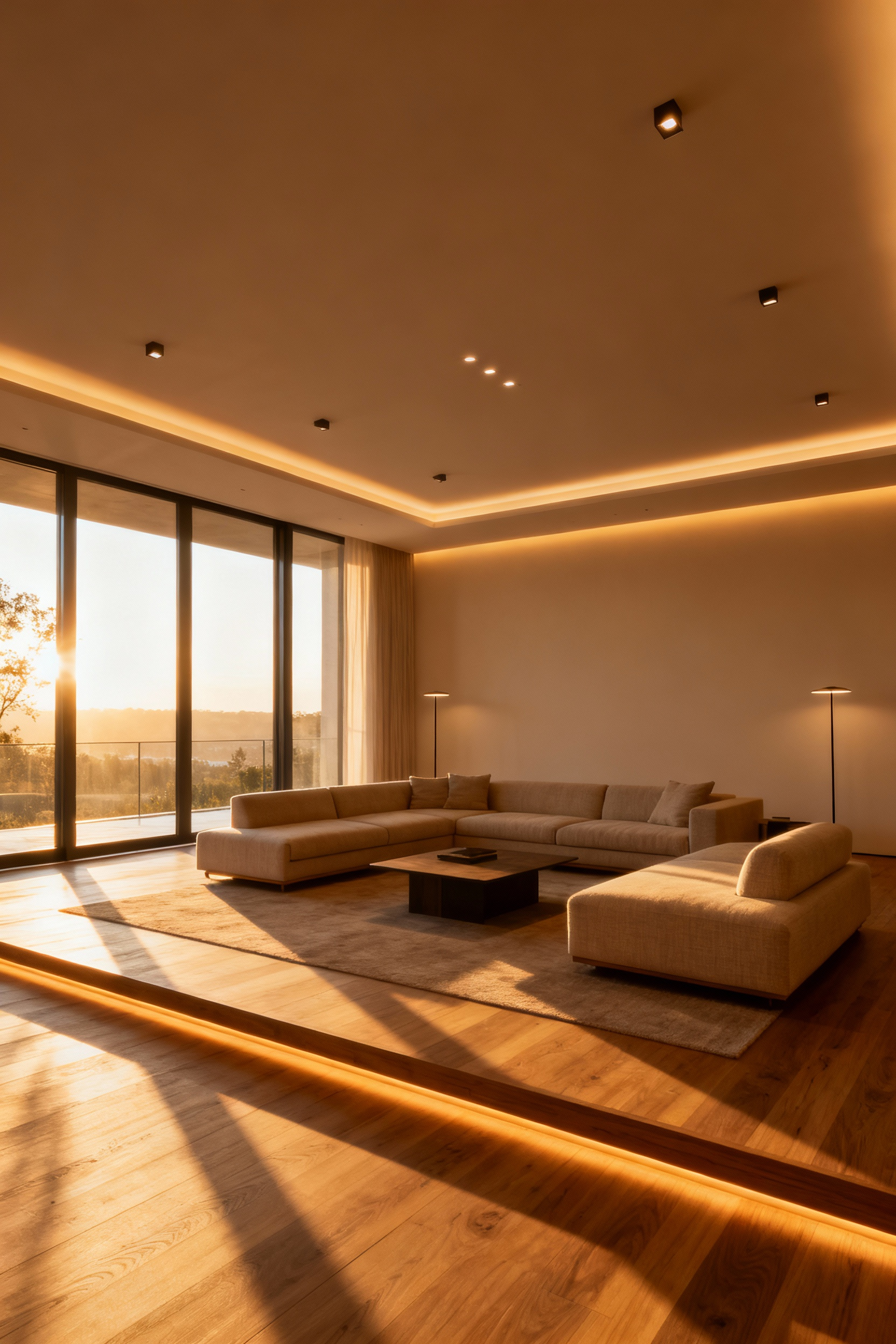
From a curatorial standpoint, this matters deeply. In a museum, we can’t be constantly replacing bulbs over delicate artworks. We need reliable, stable, and efficient light sources. Bringing this same professional standard into your home ensures that your beautiful lighting plan will perform consistently for years to come. It’s a choice that reflects a commitment not just to beauty, but to smart, sustainable, and enduring design.
Conclusion
You now hold the secrets to transforming your living room from a space that is simply lit to one that is truly illuminated. We’ve journeyed from the core philosophy of light as a narrative tool to the practical application of sculpting zones and integrating technology that enhances your life. Light is no longer just a utility; it is your final, most powerful tool for artistic expression in your home.
The single most important takeaway is to be intentional. See your room as a canvas and your lights as your brushes. Create depth with layers, tell stories with contrast, and craft moods with color and shadow. Trust your eye, as any great curator does. Start with one small change—a dimmer, a new table lamp, a single accent light on a favorite object—and feel the difference it makes. You now have the curatorial confidence to sculpt a living room that doesn’t just function, but shines.
